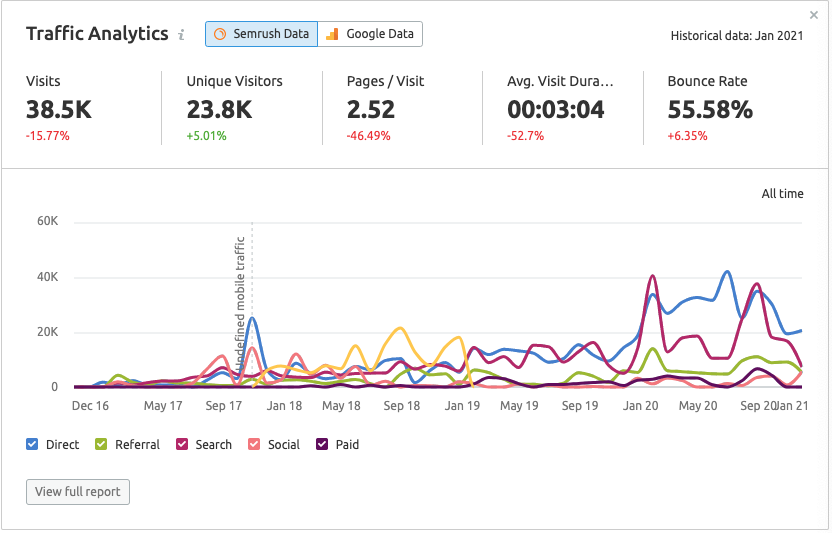What Does a Holistic SEO Content Strategy Look Like?
SEO is a fast-paced world. It seems like every day there’s an update, a new best practice or a new tool to learn. As soon as you get down the basics of technical SEO, you learn there’s a whole different side to it: content strategy.
A holistic SEO strategy that includes technical SEO as well as on-page growth content is essential to increasing organic traffic – and helping to improve lead generation, acquisition, and revenue. It’s also highly personalized to your business and involves a lot of moving pieces. Here’s how to ensure your SEO content strategy is effective and efficient.
What is growth content?
Growth content includes landing pages, blogs, product pages, and so on that are designed to rank in Google. When you appear at the top of the SERPs (search engine results pages), people who are searching for the particular topics you are targeting will discover your brand, click through to your website, and – if your growth content strategy does its job – stay there and make a purchase.
So how do you make a successful growth content strategy? At Tuff, we use site traffic analysis, competitive review, and keyword gap analysis to create a strategy for building content that’s always helpful, engaging, informative, and that gives you a timeline and projections that put the future in focus.
Do I need a growth content strategy?
Got your eye on long-term growth? Chances are you need a content strategy. True, paid ads drive quick wins, but real staying power and long-term revenue growth comes from a content strategy designed to drive (and keep!) stronger, more engaged traffic over time.
Some content strategies work more quickly than others – for example, refreshing existing content and filling gaps in your buyer funnel are both “low-hanging fruit.” But overall, a holistic SEO content strategy isn’t meant to be a quick fix. It’s a series of actions and content pieces that build up your credibility over time until you’re outranking your competition and bringing more customers to your site.
Step 1: Do your research
Before you dive in, take a step back and do your research. A truly holistic strategy includes elements of content analysis, audience research, and SEO analysis.
- Who are my competitors? You can’t outrank your competitors without identifying them first. We think of competitors in two different ways. One type of competitor is an organization that directly competes with you; agents or sellers might consistently pitch you against them. The other is the competitor that ranks high on the search terms we’d like to rank for.
- What are my competitors doing? In addition to performing an SEO competitive analysis, we also take a deep dive into our competitors’ existing content. What does their content look like? How regularly are they publishing? You’ll want to stand out just enough in terms of tone of voice and imagery, while also following established best practices.
- Who is my target audience? Defining your target audience helps you choose your content topics and build a strategy that answers their questions. That’s why we work so hard to define and understand a target audience for your growth content strategy.
- What tools do I use? There are many SEO tools out there. We use SEMRush to perform a keyword gap analysis to glean important takeaways.
Step 2: Define your strategy
All that research you did in step 1 will reveal the content strategy that will benefit you the most – but you must know where to look. Research will reveal different gaps and goals for everyone, so there’s no real blueprint here. This is where it’s super helpful to have the guidance of an expert that can spot opportunities and overlay a strategy designed to be efficient, effective, and keep goals in sight.
We have tons of examples of growth marketing strategies we can share with you. Here’s one we compiled for a client with a relatively new business and a site that didn’t have much content:
- Create content to capture searches that are at the top of the funnel. This means focusing on long-term keywords to grab impressions and clicks at the beginning of the customer journey.
- Ensure all pieces of content are rich with keywords and, more importantly, that those keywords are followed by useful information for SMEs.
- Target high-traffic keywords and create content that will capture traffic. We want to go after industry-specific terms that the customers you want are searching for.
- Ensure your landing pages are working for you. We’ll test your landing pages to ensure they’re answering audience questions and helping to initiate action.
- Creating guides, how-tos, and informational content for your blog. This will help us construct pillars that we can back link to creating a content web.
Step 3: Determine your focus keywords
No SEO strategy is complete without keywords. As part of on-page SEO, they’re vital to ensuring that whatever is produced is targeted and strategic. Google is clear on how to get your content to rank: Answer your audience’s questions in a concise, authoritative way. But what should your keywords be?
After you perform a keyword gap analysis among your competitors look for opportunities in the 10,000+ keywords where the competition is lower (<75) – lower competition means you’ll have a better chance to rank. Then whittle those down to a more manageable number.
Next hone in on projections. If you start with a pillar piece, you can estimate that if you get on page 1 you can get a piece of the total keyword traffic volume. Do this by taking the total volume of keywords for that piece of content and estimating around 15% of that total.
Sound complicated? It’s just another day on the job for our SEO experts.
Step 4: Set traffic targets
Growth marketing always comes back to one thing: your goals. And when it comes to SEO content strategy, one of the most important growth marketing metrics is traffic: 60% of marketers say that inbound – which includes SEO and blog content – is their highest quality source of leads. When your traffic goes up, your leads and revenue should follow.
In most cases, you’ll want to see key indicators of growth such as higher search rankings and new traffic within 60–90 days of publishing. Then, within four to five months you’ll want to see significant traction toward your client acquisition goals.
Based on your existing organic growth and your growth content plan, benchmark what your organic traffic is like now and set a goal for how much you want it to increase. Then, take the CVR of your current organic traffic and use it to make a projection about how many new customers/clients your new strategy will drive.
Step 5: Execute and report
It’s go time. Content is most effective when it’s published consistently over time, so put together your content calendar and get writing. If you’re overwhelmed by the sheer amount of content, enlist help. You can find freelance writers on Upwork, LinkedIn, Fiverr, and more.
Provide them with an outline of the topic and keywords, plus guidelines on your brand identity and style. Even though this is performance content designed to generate traffic, it will also serve as an introduction to your brand for many people, so make sure your tone of voice is consistent and on point.
Creating and managing a holistic SEO content strategy is pretty involved. Use a project management software to stay organized (we use Trello). You’ll also want to keep a simple spreadsheet that showcases performance and helps you understand what’s generating the most traction over time. SEO content strategy is an ongoing process that is always being updated, refined, and improved to get the best results.

Ellen is the founder at Tuff and one of the team’s core growth marketers. She is a versatile marketer with expertise in multiple channels – from ppc to seo to email to others – responsible for the experiments and testing. She is happiest when she’s on the ski hill or outside pointing her mountain bike downhill.







